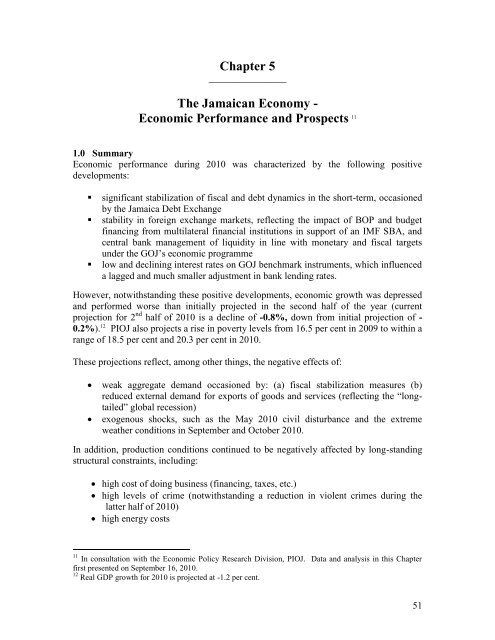PIOJ Growth-Inducement Strategy - Planning Institute of Jamaica
PIOJ Growth-Inducement Strategy - Planning Institute of Jamaica
PIOJ Growth-Inducement Strategy - Planning Institute of Jamaica
Create successful ePaper yourself
Turn your PDF publications into a flip-book with our unique Google optimized e-Paper software.
Chapter 5<br />
________________<br />
The <strong>Jamaica</strong>n Economy -<br />
Economic Performance and Prospects 11<br />
1.0 Summary<br />
Economic performance during 2010 was characterized by the following positive<br />
developments:<br />
• significant stabilization <strong>of</strong> fiscal and debt dynamics in the short-term, occasioned<br />
by the <strong>Jamaica</strong> Debt Exchange<br />
• stability in foreign exchange markets, reflecting the impact <strong>of</strong> BOP and budget<br />
financing from multilateral financial institutions in support <strong>of</strong> an IMF SBA, and<br />
central bank management <strong>of</strong> liquidity in line with monetary and fiscal targets<br />
under the GOJ’s economic programme<br />
• low and declining interest rates on GOJ benchmark instruments, which influenced<br />
a lagged and much smaller adjustment in bank lending rates.<br />
However, notwithstanding these positive developments, economic growth was depressed<br />
and performed worse than initially projected in the second half <strong>of</strong> the year (current<br />
projection for 2 nd half <strong>of</strong> 2010 is a decline <strong>of</strong> -0.8%, down from initial projection <strong>of</strong> -<br />
0.2%). 12 <strong>PIOJ</strong> also projects a rise in poverty levels from 16.5 per cent in 2009 to within a<br />
range <strong>of</strong> 18.5 per cent and 20.3 per cent in 2010.<br />
These projections reflect, among other things, the negative effects <strong>of</strong>:<br />
<br />
<br />
weak aggregate demand occasioned by: (a) fiscal stabilization measures (b)<br />
reduced external demand for exports <strong>of</strong> goods and services (reflecting the “longtailed”<br />
global recession)<br />
exogenous shocks, such as the May 2010 civil disturbance and the extreme<br />
weather conditions in September and October 2010.<br />
In addition, production conditions continued to be negatively affected by long-standing<br />
structural constraints, including:<br />
high cost <strong>of</strong> doing business (financing, taxes, etc.)<br />
high levels <strong>of</strong> crime (notwithstanding a reduction in violent crimes during the<br />
latter half <strong>of</strong> 2010)<br />
high energy costs<br />
11 In consultation with the Economic Policy Research Division, <strong>PIOJ</strong>. Data and analysis in this Chapter<br />
first presented on September 16, 2010.<br />
12 Real GDP growth for 2010 is projected at -1.2 per cent.<br />
51
















